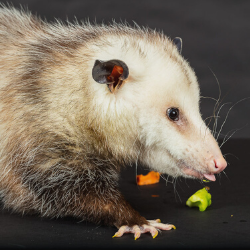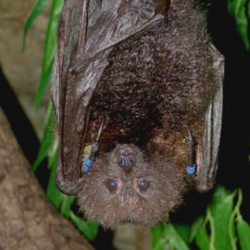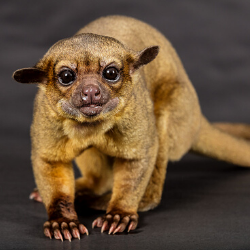What’s the buzz? Well, since September is National Honey Month, we have been thinking a lot about our pollinators. They are the bee’s knees! Of course, not every pollinator brings us honey, but they do all have an important role to play in our environment! Read on to meet a few of the pollinators at the Akron Zoo!
Butterflies
 Many insects aid in the pollination of flowers and crops, including butterflies! These beautifully colored creatures can often be seen gracing our backyard flowering plants. Unfortunately, butterflies are not as common as they once were, especially monarchs. This is due to decreased food sources, increased use of pesticides and even climate change, all of which negatively impact butterfly migration. To assist butterfly species, many organizations (including your Akron Zoo) have built monarch waystations and other butterfly gardens, which provide a desperately needed food source for monarchs: milkweed! By planting milkweed and other flowering plants, which are free of pesticides gives butterflies a safe place to rest, eat, and even lay their eggs during their annual migration. Click here to learn more about butterflies and how you can help them!
Many insects aid in the pollination of flowers and crops, including butterflies! These beautifully colored creatures can often be seen gracing our backyard flowering plants. Unfortunately, butterflies are not as common as they once were, especially monarchs. This is due to decreased food sources, increased use of pesticides and even climate change, all of which negatively impact butterfly migration. To assist butterfly species, many organizations (including your Akron Zoo) have built monarch waystations and other butterfly gardens, which provide a desperately needed food source for monarchs: milkweed! By planting milkweed and other flowering plants, which are free of pesticides gives butterflies a safe place to rest, eat, and even lay their eggs during their annual migration. Click here to learn more about butterflies and how you can help them!
Opossum
 As the only marsupials in North America, opossums are already unique mammals, but did you know they are also pollinators? These opportunistic omnivores will eat whatever they can find, including fruit. When they climb through the trees to collect and eat ripe fruit, their fur also picks up pollen and carries it to the flowers of other trees. Unfortunately, opossums often get a bad rap since many people believe that they may carry and spread rabies. Good news: this is a myth! Opossums are highly unlikely to have rabies, since their body temperatures are so low. Instead, these sweet animals make great neighbors, since they help control the populations of many backyard pests, like ticks!
As the only marsupials in North America, opossums are already unique mammals, but did you know they are also pollinators? These opportunistic omnivores will eat whatever they can find, including fruit. When they climb through the trees to collect and eat ripe fruit, their fur also picks up pollen and carries it to the flowers of other trees. Unfortunately, opossums often get a bad rap since many people believe that they may carry and spread rabies. Good news: this is a myth! Opossums are highly unlikely to have rabies, since their body temperatures are so low. Instead, these sweet animals make great neighbors, since they help control the populations of many backyard pests, like ticks!
The Akron Zoo is also home to an opossum, Marsi. Marsi was rescued as a joey by the Penitentiary Glen Nature Center when her mother was killed by a vehicle. Since she was raised by humans, Marsi was not equipped to take care of herself in her natural habitat, so she was moved to the Akron Zoo where she serves as one of our animal ambassadors! Now this sweet girl gets to help us educate thousands of guests each year.
Bats
 Due to their unique eating habits, bats are some of the most important pollinators throughout much of the world, especially in the tropics. Fruit bats are responsible for pollinating over 300 species of fruit, including bananas, mangos, guava, and agave. When bats leave in search of food each night, they look for trees with overripe fruit to eat. Their strategy is to fly down, grab a large chunk of fruit and fly off to avoid predators like snakes, who often wait and attempt to ambush them. As fruit bats take this fruit from one tree to another, they disperse seeds and pollen much further than the tree could spread them on its own. You can learn more about bat species at the Akron Zoo and around the world here.
Due to their unique eating habits, bats are some of the most important pollinators throughout much of the world, especially in the tropics. Fruit bats are responsible for pollinating over 300 species of fruit, including bananas, mangos, guava, and agave. When bats leave in search of food each night, they look for trees with overripe fruit to eat. Their strategy is to fly down, grab a large chunk of fruit and fly off to avoid predators like snakes, who often wait and attempt to ambush them. As fruit bats take this fruit from one tree to another, they disperse seeds and pollen much further than the tree could spread them on its own. You can learn more about bat species at the Akron Zoo and around the world here.
Lemurs
 Madagascar is home to the world’s largest pollinators: lemurs. The largest of these pollinators is the black and white ruffed lemur, who are the main pollinators of the traveler’s palm. These palm trees are an average of 40 feet tall, and its flowers are specialized for pollination by large, non-flying animals. The flowers are surrounded by tough leaves that take strength to open, and they provide enough nectar to feed a large animal. Once the flowers are open, lemurs use their long snouts and tongues to reach the nectar inside. As a result, they collect pollen on their muzzle and fur, and then transport it to the next flower, allowing for pollination and the growth of a greater food supply!
Madagascar is home to the world’s largest pollinators: lemurs. The largest of these pollinators is the black and white ruffed lemur, who are the main pollinators of the traveler’s palm. These palm trees are an average of 40 feet tall, and its flowers are specialized for pollination by large, non-flying animals. The flowers are surrounded by tough leaves that take strength to open, and they provide enough nectar to feed a large animal. Once the flowers are open, lemurs use their long snouts and tongues to reach the nectar inside. As a result, they collect pollen on their muzzle and fur, and then transport it to the next flower, allowing for pollination and the growth of a greater food supply!
Kinkajou
 Kinkajous are very important pollinators in Central and South America. Though they appear to be closely related to monkeys or lemurs, kinkajous are actually most closely related to the North American raccoon. Kinkajous are sometimes called honey bears, both for the color of their fur and because they raid bees' nests. They use their long, skinny tongues to slurp honey from a hive, and also to remove insects like termites from their nests. They also use their long tongs to drink nectar from flowers. While visiting these flowers, they also aid in the pollination process.
Kinkajous are very important pollinators in Central and South America. Though they appear to be closely related to monkeys or lemurs, kinkajous are actually most closely related to the North American raccoon. Kinkajous are sometimes called honey bears, both for the color of their fur and because they raid bees' nests. They use their long, skinny tongues to slurp honey from a hive, and also to remove insects like termites from their nests. They also use their long tongs to drink nectar from flowers. While visiting these flowers, they also aid in the pollination process.
The Akron Zoo is also home to one honey bear, Chloe, who is an animal ambassador. Like her native counterparts, Chloe loves sweet foods. Instead of nectar, however, her favorite snacks are grapes, blueberries, melon, pineapple, apples, jelly, honey and maple syrup! Chloe is very smart and loves learning new behaviors. She is very curious and likes spending one on one time with the people she’s formed relationships with.
“She loves hanging out with us and just falling asleep,” says Education Keeper, Todd Boerner. “I often spend time with her by talking to her while she is curled up near me. Doing her favorite things allows us to form a bond and relationship in which then we can train many behaviors for programming and husbandry. Plus, she loves cuddling and getting rub downs by people she likes.”
We are glad you took the time to meet some of our Akron Zoo pollinators! Now that you have met a few of our animals, be sure to swing by and to see your other favorite Akron Zoo residents. With your admission, we are able to continue to provide exceptional care and realistic habitats for the more than 1,000 animals in our care. We are looking forward to your visit!
